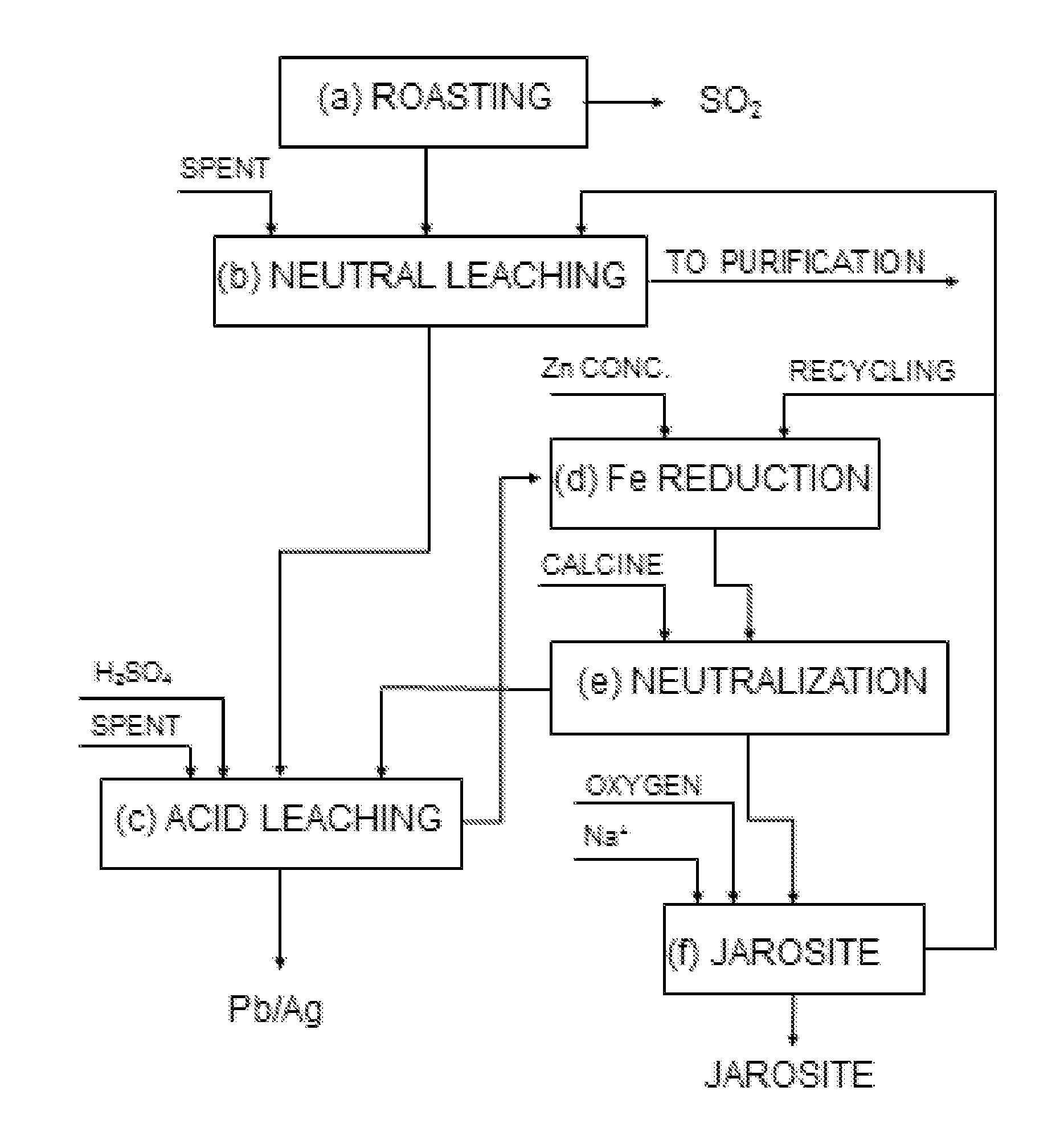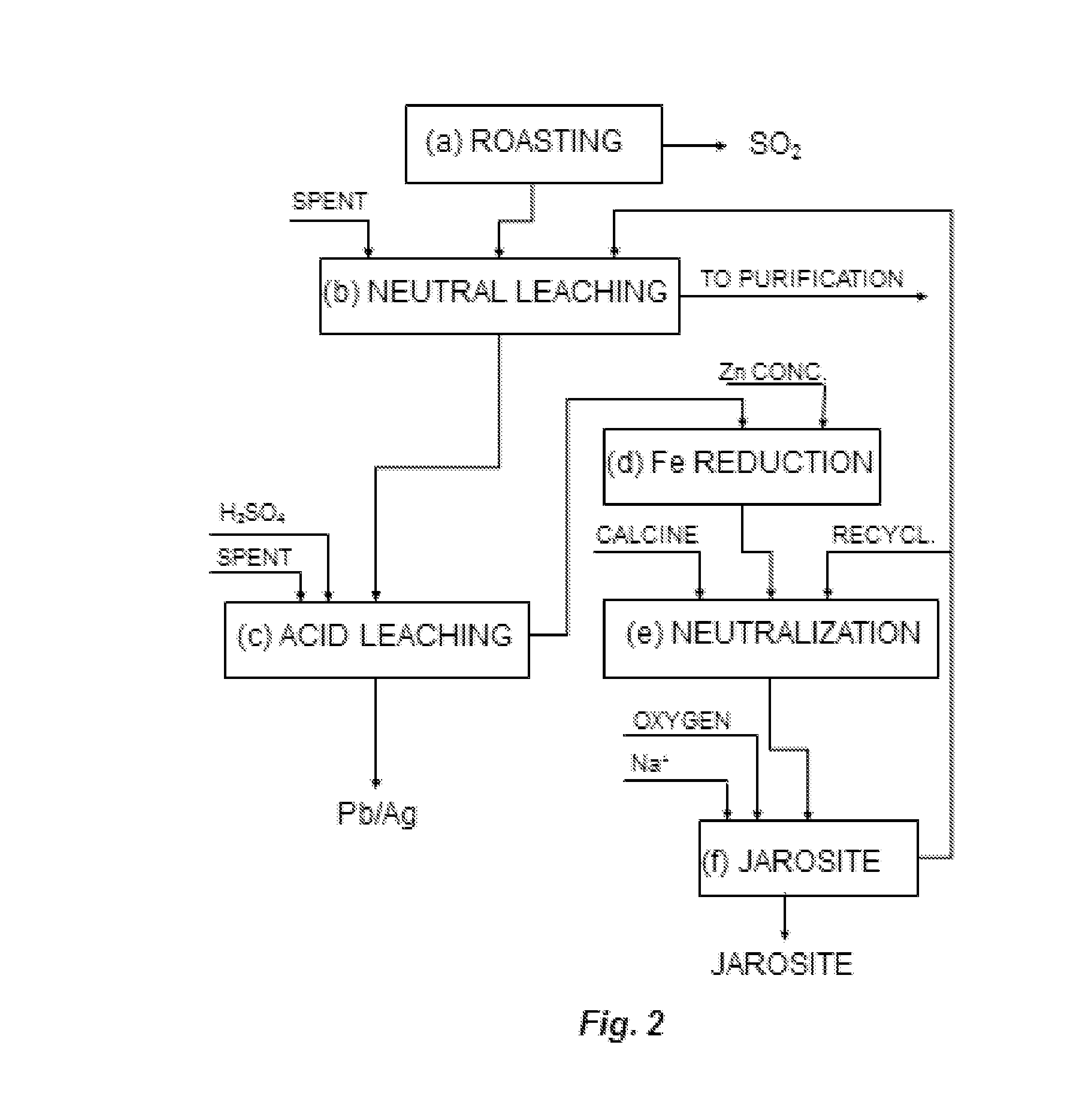In order to obtain
zinc metal from its raw materials, mainly
zinc sulphide concentrates, both the pyrometallurgical and the hydrometallurgical routes have been used, although the first of these is clearly coming into disuse due to the high operating costs and the environmental problems associated to this process.
This process differs from the process described above in that both the leaching of ferrites and the
precipitation of iron as jarosite take place simultaneously, although in this process it is not possible to separate the lead-silver residue, obtaining at the end a single residue containing all the iron in the form of jarosite as well as the lead, silver and silica contained in the calcine.
Nevertheless, this process is not cost effective and therefore has never been developed at the industrial level.
However, the zinc
recovery rate of this process is lower than the one obtained with the jarosite process.
The remaining content is lost together with the iron residue, thereby contaminating it.The recovery rate for
copper does not exceed 80%, since the iron residue contains appreciable quantities of this
metal.The amount of impurities accompanying the iron residue, jarosite,
goethite or paragoethite (zinc and lead as already mentioned, as well as
arsenic and / or
copper when zinc concentrates are treated with appreciable contents of these elements) means that the residue cannot be used for any other process and has to be stored in safety ponds, becoming a major environmental liability.
In the case of jarosite, environmental regulations do not allow it to be stored in the form it is generated by the zinc manufacturing process, and therefore it has to be first rendered
inert by mixing it with
lime and
cement (jarofix process), before it can be stored in safety ponds.Currently, certain countries have already banned the practice of storing this kind of residue (Netherlands, Japan, Australia), while another group of countries allow it to be stored in existing ponds but no longer permit the construction of new storage ponds (France, Belgium, Germany).
This situation is becoming more restrictive as
environmental pressure grows, demanding cleaner and more efficient technologies for the electrolytic zinc production.
In this regard, during the last 30 years intensive research work has been conducted in the field of zinc production searching for a manageable and economically competitive process which has a high
metal recovery rate, although to date, no satisfactory solution has been found.
However, this procedure presents a series of difficulties that are probably the reason why it has not been possible to apply it to industrial processes.
This entails an unacceptable risk for people and facilities, unless autoclaves are used.
The consequences derived from the required operating conditions are high steam consumption, increasing the volume of the necessary equipment, and a considerable increase in the consumption of flocculant.
Proof of the lack of success achieved to date is that today none of these processes that attempted to improve the quality of the iron residue is being used and this residue continues to be stored in safety ponds, with the exception of a
plant that generates
hematite and those which use pyrometallurgical processes for treating the residues.
The fundamental difference contributed by the process described in this document is that the maximum working acidity is limited, thereby limiting the admissible
iron content of the initial solution and using non-polluting neutralizing agents according to the availability of those materials at the
plant.
This procedure works well and is suitable for those plants that operate with zinc concentrates having low iron content (up to 5 of 6%), but it is not appropriate for treating zinc concentrates with high iron contents, since the procedure itself limits the maximum iron content in the solution that is treated during the iron oxidation and jarosite
precipitation stage.
While in the first case the procedure described in document PCT ES 2011 / 070265 could be applied without any problem, in the second case applying that procedure would generate an excessively high acidity during the jarosite stage that would prevent the iron from precipitating efficiently, leaving a considerable amount of iron in the final solution.
This would require a high amount of iron recirculating through all the leaching stages, as indicated later in the present document, unless the neutralizing agent would be used in quantities that are not usually available at production plants, which would also generate additional costs and the additional problem derived from using BZS as neutralizing agent, as it dilutes jarosite residue (therefore increasing its volume), a situation which is not recommended on economic grounds.
This condition, according to the procedure described, is only attained by limiting the iron content of the zinc concentrates treated, which entails an inconvenience for a good part of the zinc producers that would see their capacity for treating the concentrates available in the market limited by this condition.
This may affect the stability of the process as a whole, because first, during the acid leaching and jarosite precipitation stages steam is consumed to heat the solutions, and the larger the flow of these stages the larger the amount of steam needed.
Currently there are some electrolytic zinc plants using the jarosite process that are encountering difficulties to maintain the stability of the leaching
plant because they operate in such a manner that the iron recycled in the process is in the order of 50%.
 Login to view more
Login to view more 


